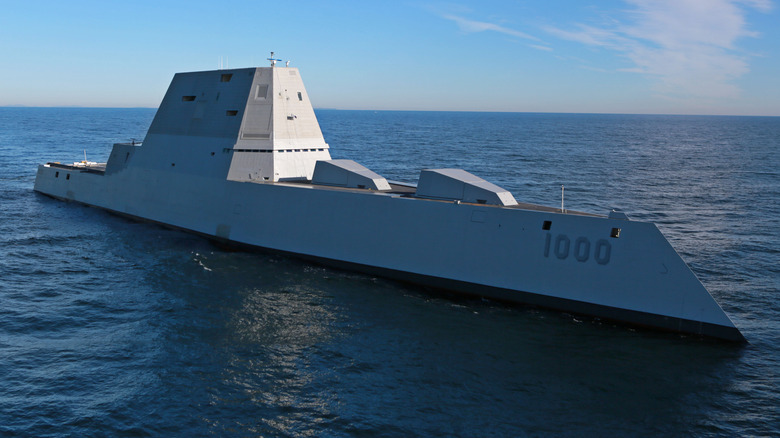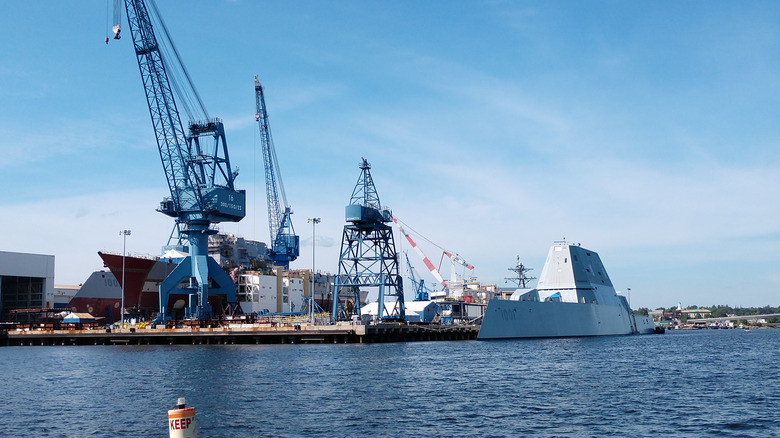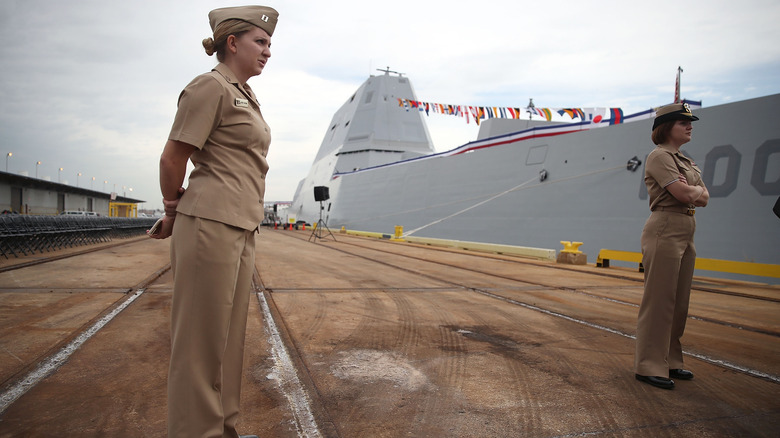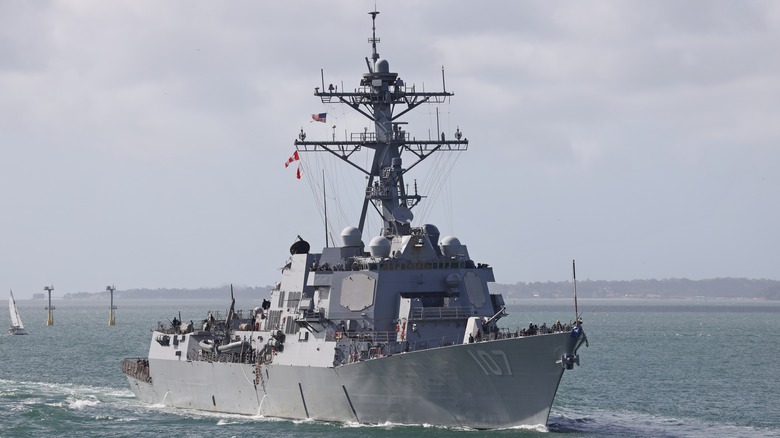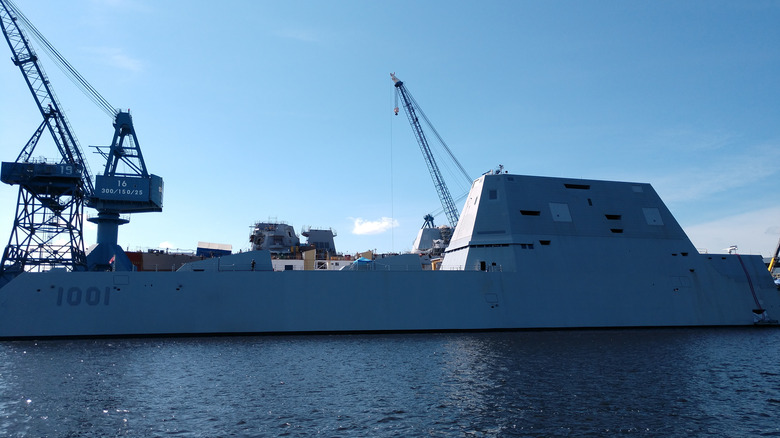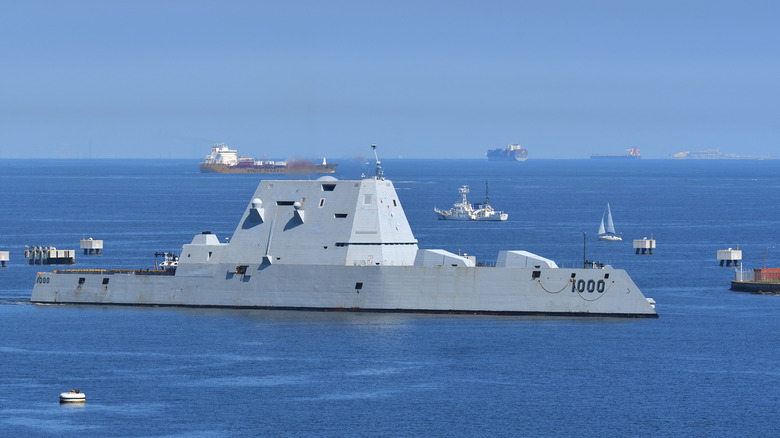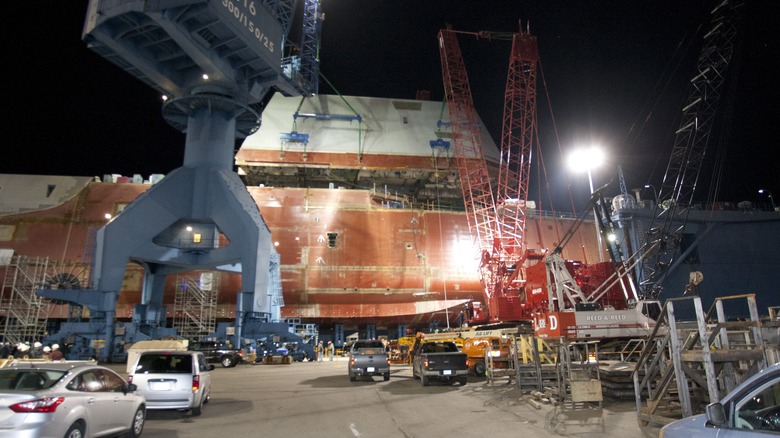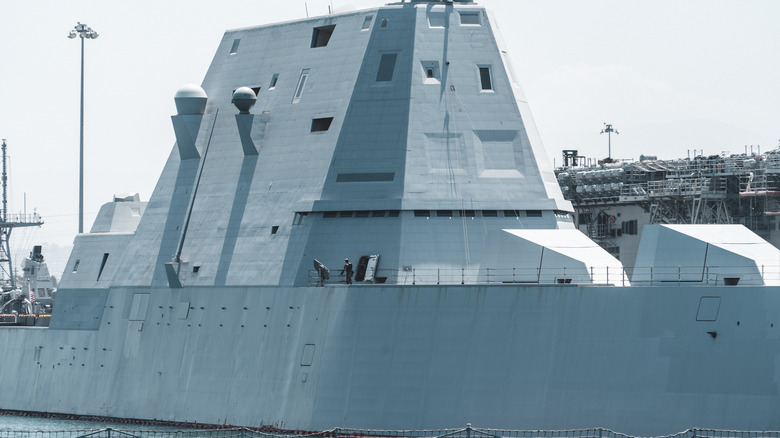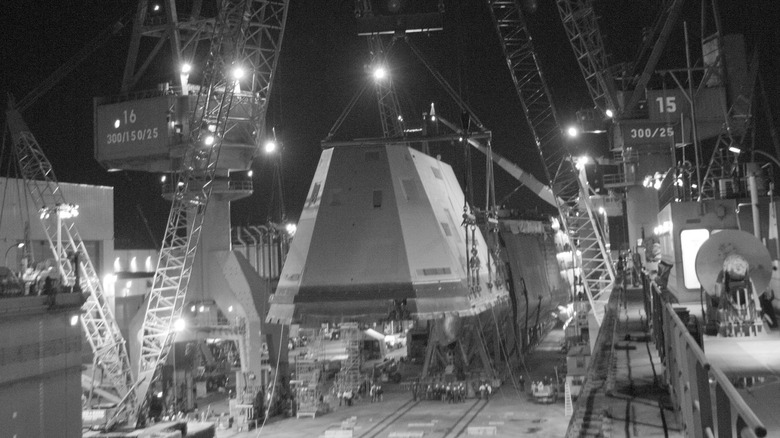Why The U.S. Canceled A $22 Billion Stealth Ship Project
The U.S. splurges on its armed forces. In 2022, the country spent $877 billion on defense spending, which was $71 billion more than it spent in 2021. In 2023, the Department of Defense's budget will be a colossal $2.01 trillion, with 922.56 billion already committed to be spent. Comparatively, the combined 2022 defense budgets of China, Russia, India, Saudi Arabia, Germany, France, South Korea, Japan, Ukraine, and the United Kingdom only came up to $849 billion. However, just because the U.S. spends more on its military branches than other countries doesn't necessarily mean it has money to burn.
In the mid-to-late 2000s, the Navy began work on what was supposed to be the next generation of destroyers — the Zumwalt-class. For those unfamiliar with contemporary naval terminology, destroyers are fast-yet-heavy warships designed to escort and defend other ships. The Navy had high hopes for this project and wanted to use a complement of 32 new destroyers as the backbone of future naval fleets.
Most importantly, even though these ships would be larger than the average destroyer, they would be built around stealth technology and therefore be harder to detect on radar. Ultimately, the Navy spent around $22 billion on the Zumwalt project, which was unceremoniously canceled. However, a total of three Zumwalt-class destroyers will be built, as two have technically already been completed and the third is currently under construction.
So what happened? Here is why the Zumwalt-class destroyers didn't quite live up to the hype.
What is a Zumwalt-class destroyer?
Nearly every military vehicle the U.S. has used was technologically advanced for its time. However, as technology marches on, these vehicles become obsolete. When that happens, the military has to replace the aging devices.
In the early 1990s, the U.S. Navy started the DD-21 program, which later evolved into the DD(X) program and soon became the Zumwalt-class — or DDG 1000-class — destroyer. The ship was intended to replace the recently retired Iowa-class battleships and Aegis destroyers. While Zumwalt-class destroyers are some of the largest combat ships in the Navy, they function with much smaller crews. Zumwalts were also intended to be the stealthiest destroyers out there. Despite their size, the angular hull design would give them a radar cross-section no larger than a fishing vessel and would be 50 times harder to spot with radar than comparable destroyers.
Originally, the Navy wanted a full complement of 32 Zumwalt-class destroyers but soon reeled back its plans. The Navy reduced the number of Zumwalts to 16, increased it to 24, scaled plans back to 7, and finally settled on 3. Currently, only one Zumwalt-class destroyer, the USS Zumwalt, is complete. Construction started in 2009 and finished in 2016 and was built by General Dynamics Bath Iron Works. The second Zumwalt-class destroyer, the USS Michael Monsoor, was fully commissioned but lacks combat capabilities, whereas the third Zumwalt, the USS Lyndon B. Johnson, is under construction.
The project wasn't supposed to cost $22 billion
The U.S. military is no stranger to spending (or overspending) money on various new weapons of war. For instance, the Boeing F/A-18 Super Hornet cost the government a total of $51 billion, but it earned that price tag with its lethality and versatility. So why was the Zumwalt-class destroyer project canceled when it cost less than half the Super Hornet? Because it was supposed to cost even less than that.
Early in the Zumwalt-class destroyer project, proposals and allotted budgets were actually fairly reasonable. Initially, the U.S. Navy was confident each ship would cost around $1.34 billion, bringing the project total to $46 billion for 32 ships in total. However, costs kept ballooning. Each of the three current ships eventually cost an average of over $7 billion after taking into account the $10 billion development costs.
So why did the U.S. Navy cancel the Zumwalt project when it reached a cost of around $22 billion when the original plan called for a budget of $46 billion? Well, it turns out that the Nunn-McCurdy Amendment automatically terminates any government project that goes 50% over the originally proposed budget in order to nip sunk cost fallacies in the bud — unless the Secretary of Defense can prove that a project is crucial to national security.
Given the Zumwalt project's fate, it's probably safe to assume that few people, if any, believed the destroyer's usefulness outweighed its swelling costs.
The government changed its priorities
Military projects must balance existing and emerging technologies with developing and predicted threats. The ability to quickly churn out new platforms isn't always as important as adapting to new information.
During a congressional hearing in 2008, U.S. Navy officers stated that they no longer needed Zumwalt-class destroyers and were instead interested in requisitioning more Arleigh Burke-class destroyers. According to their rationale, the global threat picture had shifted in a way that made Zumwalts unnecessary. Given other reports at the time, the Navy might have backtracked on their Zumwalt plans because the ships were a liability.
According to the Washington Post, many senators and Naval officers canceled the Zumwalt project in response to 15 classified intelligence reports. These reports stated that Zumwalt-class destroyers were particularly vulnerable to "a range of foreign missiles."
One such threat was an in-development Chinese ballistic missile based on the DF-21. Vice Admiral Barry McCullough explained that the Zumwalts were incapable of effectively operating a ballistic missile defense system since they lacked the combat systems to guide standard air defense missiles such as the Standard Missile-2 (SM-2), SM-3, or SM-6. Essentially, the Zumwalts were capable of firing the missiles but lacked the ability to connect them with their targets — which is kind of important when defending against incoming ballistics.
Too many technical issues to count
Every new piece of technology goes through inevitable growing pains with glitches and malfunctions. However, military vehicles can't really afford these problems once in use. A single mechanical hiccup in, say, a fighter jet can lead to catastrophe and result in the cancelation of an entire model of planes. The Zumwalt-class destroyer, meanwhile, experienced numerous issues.
The USS Zumwalt has encountered an uncomfortable number of technical issues in its short tour of duty, including stalled engines. The most embarrassing example of this specific problem occurred in 2015 when the ship's propellers seized up in the middle of the Panama Canal. The USS Zumwalt had to be towed out of the canal, and to make matters worse, that was the third major engineering issue to hit the destroyer within the span of several months. This seeming engine curse wasn't limited to the first Zumwalt-class destroyer, either.
During 2018 sea trials, the second Zumwalt-class destroyer, the USS Michael Monsoor, damaged the turbine engine blades that powered its main generator. Apparently, the turbine didn't malfunction while the ship was at sea, but a post-trials inspection using a borescope revealed that the blades had somehow been damaged, which meant the turbines had to be replaced before the USS Michael Monsoor set sail for San Diego to begin combat system activation.
The Zumwalt wasn't as stealthy as advertised
The U.S. military fields numerous stealthy vehicles. Even when they aren't purpose-built for stealth, many military vehicles are designed to keep as low of a profile as possible. Well before the Zumwalt project, the U.S. Navy was minimizing radar cross sections with ships such as Arleigh Burke-class destroyers and Constellation-class frigates. The Zumwalt was supposed to take radar cross section reduction to the extreme but didn't quite make it.
The Zumwalt-class destroyer was originally intended for covert shore bombardment. The ship is fast, able to operate in complete darkness, and difficult to detect via radar. However, defense analyst Mike Fredenburg shared his doubts in the National Review. He stated that the Zumwalt's stealth would be moot in its primary field of deployment (crowded close-to-shore areas), and even if enemies couldn't see the ship on radar, Fredenburg was confident the Zumwalt's huge size would be a liability.
Moreover, the USS Zumwalt might not have been as invisible to radars as advertised. Long-range over-the-horizon radar systems have been known to detect stealth ships under the right conditions, which reduces the Zumwalt's stealth capabilities even more. While many officials initially doubted the USS Zumwalt could fulfill its role as a stealth shore bomber, plenty have softened their positions and believe the ship can successfully confound enemies and their radars. Plus, given the USS Zumwalt's speed, enemy combatants who can actually visually identify the destroyer won't have enough time to react before they're blown to smithereens.
Armaments didn't live up to promises
Destroyers are built to destroy enemy ships. To fulfill this function, they are generally armed to the gills with weapons that can engage numerous hostile crafts from different ranges. Of course, it helps if these weapons actually work, have enough ammo, and actually exist.
At first glance, the USS Zumwalt's weaponry sounds impressive. The ship sports two 30mm close-in gun systems and eighty peripheral vertical launch cells for anti-submarine rockets and Tomahawks, Evolved Sea Sparrows, and Standard Missiles. However, the vessel was supposed to carry much more.
Zumwalt-class destroyers were designed to bear as many as 128 cells and built as a platform for the unique Advanced Gun System (AGS). This weapon would have fired Long Range Land Attack Projectiles, and while the AGS gun was successfully assembled and loaded onto the USS Zumwalt, it had no ammunition. Each shell cost $800,000, which was deemed too expensive. Quite frankly, many of the Zumwalt-class destroyer's weaponry issues (presumably) came down to cost. Even the ship's radar systems were gutted to save money. Without an accompanying ship for situational awareness, a Zumwalt-class destroyer can't use its weapons to their full potential.
Moreover, the USS Zumwalt's initial arsenal lacked several critical components. While the destroyer is currently equipped with Standard Missiles, earlier iterations did not and were criticized for this oversight. Even when Standard Missiles were installed, they were deemed inadequate for regular Ballistic Missile Defense use, which probably didn't win over Naval brass.
The Zumwalt wasn't that stable — or was it?
Tumblehome hulls have a reputation for being unstable and a tendency to leak. How ironic is it that the Zumwalt's tumblehome hull proved more stable than anticipated years after the project was canceled?
When the Zumwalt-class destroyer's proposal was drafted, many officials assumed its tumblehome design would suffer from instability issues. Experts in the shipwright field shared their opinions throughout the project's life. In 2007, civilian naval architect Ken Brower told Defense News that the ship "Will capsize in a following sea at the wrong speed if a wave at an appropriate wavelength hits it at an appropriate angle." According to Brower, tumblehome hulls lack the righting energy of flare designs, and if a ship pitches down, it will "basically roll over." Several retired anonymous naval officers and analysts agreed with Brower.
While it's unclear how much these fears impacted the Zumwalt project cancelation decision, it turns out analysts were making a tidal wave out of a ripple. In 2019, the USS Zumwalt sailed to Alaska during some ongoing stability testing where the Zumwalt braved waves between 13 and 20 feet high, as Captain Andrew Carlson told Defense News. However, from where the crew felt like the waves were no more than four feet high. Apparently, the tumblehome hull let the ship right itself faster than many other naval vessels. While Navy officials initially had their doubts, they are now channeling the Zumwalt's angular design for the current DDG(X) program.
The Zumwalts will be repurposed
The Zumwalt-class destroyers can't fulfill their original purpose for a multitude of reasons, and even if the Zumwalts still packed as much heat as they were supposed to, they are too few in number to serve as the backbone of modern U.S. naval forces. However, that doesn't mean the ships are completely useless — they just need a weaponry facelift.
In 2018, the commander of U.S. Strategic Command, General John Hyten, floated the idea of transforming Zumwalt-class ships into one of two specialized roles. These branching paths included a long-range anti-ship vessel and a nuclear strike platform. Both would strip the USS Zumwalt — as well as the USS Michael Monsoor and USS Lyndon B. Johnson — of their anti-aircraft and anti-submarine capabilities. However, the USS Zumwalt lagged behind in these capacities, anyway.
As of this year, the Navy has selected the nuclear option. All Zumwalt-class destroyers will be retrofitted to carry ballistic missiles and cruise missiles utilizing low-yield nuclear warheads that are tactical in use instead of strategic. These missiles will utilize the Conventional Prompt Strike (CPS) weapon system, which was designed for non-nuclear weapons. To make room for this missile launcher, the Navy is essentially scrapping the AGS — the gun it never had any ammo for to begin with.
